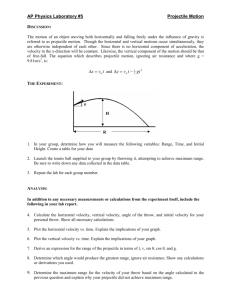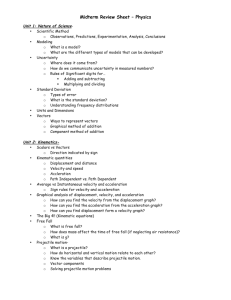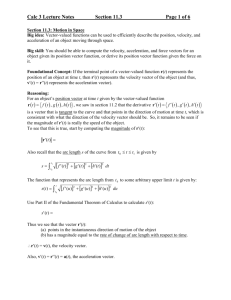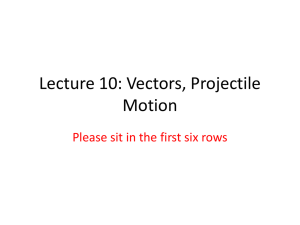Physics_12_Methods
advertisement
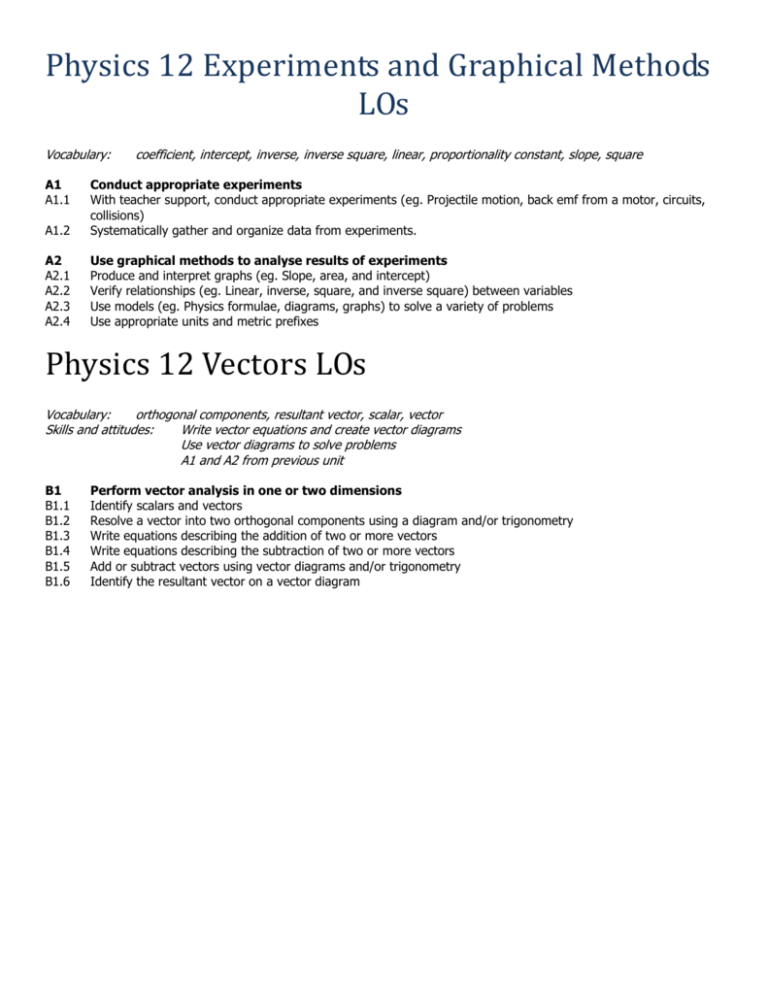
Physics 12 Experiments and Graphical Methods LOs Vocabulary: A1 A1.1 coefficient, intercept, inverse, inverse square, linear, proportionality constant, slope, square A1.2 Conduct appropriate experiments With teacher support, conduct appropriate experiments (eg. Projectile motion, back emf from a motor, circuits, collisions) Systematically gather and organize data from experiments. A2 A2.1 A2.2 A2.3 A2.4 Use graphical methods to analyse results of experiments Produce and interpret graphs (eg. Slope, area, and intercept) Verify relationships (eg. Linear, inverse, square, and inverse square) between variables Use models (eg. Physics formulae, diagrams, graphs) to solve a variety of problems Use appropriate units and metric prefixes Physics 12 Vectors LOs Vocabulary: orthogonal components, resultant vector, scalar, vector Skills and attitudes: Write vector equations and create vector diagrams Use vector diagrams to solve problems A1 and A2 from previous unit B1 B1.1 B1.2 B1.3 B1.4 B1.5 B1.6 Perform vector analysis in one or two dimensions Identify scalars and vectors Resolve a vector into two orthogonal components using a diagram and/or trigonometry Write equations describing the addition of two or more vectors Write equations describing the subtraction of two or more vectors Add or subtract vectors using vector diagrams and/or trigonometry Identify the resultant vector on a vector diagram Physics 12 Kinematics LOs Vocabulary: acceleration, acceleration due to gravity; average velocity, constant acceleration, displacement, final velocity, horizontal motion, initial velocity, kinematics, maximum height, projectile motion, projectile velocity, range, relative velocity, time, velocity, vertical motion, vertical velocity Knowledge: velocity: initial, average, final, horizontal, vertical Navigation problems Displacement Constant acceleration due to gravity Shape of the path taken by a projectile fired at some angle above the horizontal Independence of horizontal and vertical motion of a projectile Projectile motion Skills and Attitudes: From A and B (previous units) C1 C1.1 C1.2 Apply vector analysis to solve practical navigation problems Describe relative velocity Determine v, d, and t for navigation problems in 1 or 2 dimensions C2 C2.1 C2.2 Apply the concepts of motion to various situations where acceleration is constant Solve a variety of kinematics problems involving d, vo, v, vavg, a, and t Describe the shape of the path taken by various projectiles fired at some angle above the horizontal, if friction is negligible Draw conclusions about a projectile’s horizontal velocity and downward acceleration due to gravity Resolve a projectile’s velocity at any given point in time, into its horizontal and vertical components Solve projectile motion problems involving range (dx), maximum height, time of flight, displacement, velocity, and acceleration due to gravity C2.4 C2.5 C2.6




